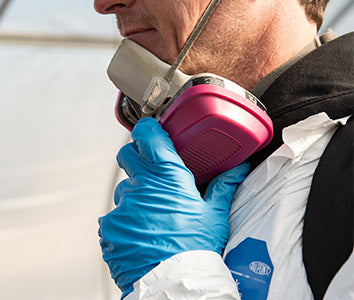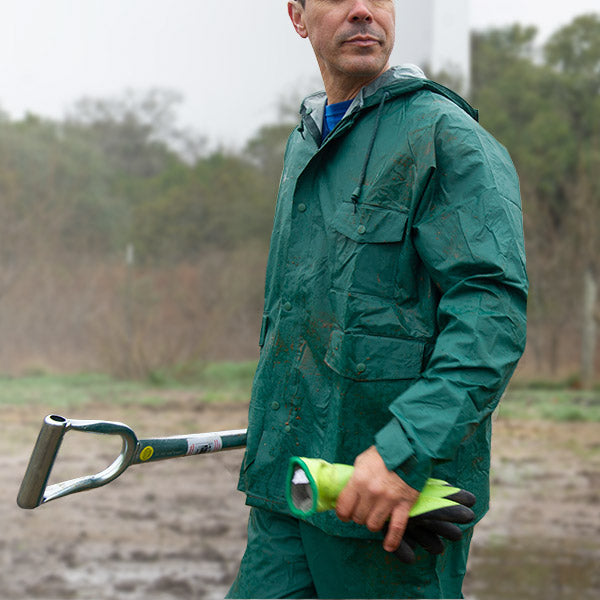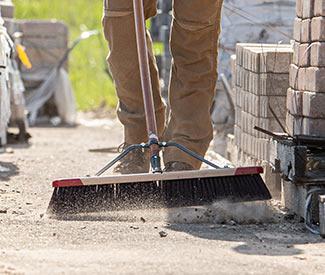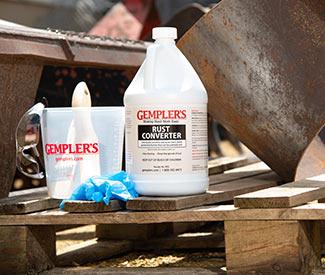Learn about the rashes, symptoms, treatment, and plant identification.
If you have other questions not shown, please contact Customer Service at 1-800-382-8473 or send us an email.
Poison Ivy, Oak and Sumac FAQs
Exposure and Active Rashes
-
What should I do if I know I've been exposed to poison plants?
Within an hour or so you should rinse with a lot of cold water; you may even consider using a garden hose to rinse off the affected areas. However, you don't want to rinse with hot water, because it will open your pores and let the urushiol oil into your skin.
Some people state that for up to six hours after exposure, washing the affected area with alcohol may still help remove the oil; however, others say that after a half an hour it is too late because the urushiol has already been absorbed into your skin and can't be removed. To err on the side of caution, wash as soon as possible.
-
What are the symptoms of a poison plant rash?
Once the urushiol oil from a plant has penetrated the skin, an allergic reaction will appear in 12 to 48 hours as a line or streak of rashes. Redness and swelling of the skin begins between 12 and 72 hours after contact with urushiol, often followed by blisters and severe itching. The blisters tend to crust and scale within a few days. The signs and symptoms can vary from mild to severe.
-
What does the rash feel like?
At first, you get an itchy spot that will get worse and worse over the course of a few hours. It can be a small itchy spot that will be more of an annoyance than anything else, or much of your body can be covered with red sores that will itch intensely. The poison ivy rash, even when it's not large and ugly, can be one of the itchiest experiences a person will endure.
-
What can I do once the itching starts?
For most cases, you can treat the affected area with an anti-itch cream, lotion, balm or salve. There are a number of products designed specifically to ease the itch of a poison ivy, oak or sumac rash. For a more serious rash, you should see a trained medical professional.
-
What are some popular home remedies for the rash?
For some people heat will ease the itching, so you can take a shower in the hottest water you can stand, which may provide a few hours of relief once the rash has broken out. Another heat option is to use a hair dryer on a low setting, being careful not to burn yourself. Some people think jewelweed will ease the itch; mash or grind up the weed and apply it directly to the affected spots. You can also spray the rash with a spray deodorant containing aluminum, which most do.
-
How long does the rash typically last?
Typically, a rash from poison ivy, oak, or sumac will last about five to 12 days. However, in extreme cases, the rash can last several weeks to a month or more depending upon treatment and how severely your body reacts to the urushiol oil from the poison plant.
-
How long is poison ivy, oak, or sumac contagious?
Once you have the rash and the oil has been absorbed into your skin, you probably can't spread it to others. If you have blisters filled with liquid and they break open, the fluid (mostly water) will not spread the rash.
-
Can the blisters cause the rash to spread?
No. The blisters will not cause the rash to spread to other parts of your body. The blisters are your body's natural reaction to the urushiol antigen. Scratching or oozing blister fluid cannot spread the antigen to other areas of your body or other people, for that matter.
-
Should I break the blisters?
Yes. Once you have broken the blister, you should apply a healing spray, cream or lotion to the affected area and loosely cover it with a sterile bandage. Do not scratch the area because you could possibly contaminate the open sores with bacteria from under your fingernails, which could cause a serious infection.
-
Should I take a bath or shower if I have the rash?
You should take a shower if you have the rash because urushiol can float on top of bath water and reattach to your skin as you exit from the bath.
What Causes a Rash from Poison Ivy, Oak, or Sumac
-
How did I come in contact with poison ivy, sumac or oak?
The rash-causing substance is in every fiber of the plant and can come in contact with the skin in many different ways. A person can get urushiol on the skin by coming in direct contact with the plants, either by touching or rubbing against the leaves. You can also come in contact with it through an indirect means, such as touching tools, clothes or other objects where the oil is present.
-
Does everyone exposed to the plants get the rash?
No. Although estimates vary, somewhere between 3–15% of the population is immune to the allergic reactions caused by contact with urushiol oil. According to the American Academy of Dermatology, up to 50 million people get the rash each year. It is the most-common allergy in the United States.
-
If I am immune to urushiol now, will I always be immune?
Some people appear to be immune to the effects of urushiol, while others may become immune to it. However, since you can gain or lose it, you should never assume that you are immune to urushiol, even if you were immune to it in the past. People do change as they get older, so it's difficult to base your current state on your past experiences. In addition, people with fair skin tend to be more susceptible than others.
-
What is urushiol?
Urushiol is a toxic and resinous substance found in all parts of poison ivy, poison oak and poison sumac. When a person comes in contact with urushiol, it binds to the skin within 10 to 20 minutes and becomes extremely difficult, if not impossible to wash off your skin with soap and water. The resulting rash is the body's natural reaction to fight off the toxin.
-
How potent is urushiol?
Urushiol is amazingly potent. Only one nanogram (a billionth of a gram) is needed to cause a rash, while the average exposure for most people is 100 nanograms.
-
How long does urushiol stay active?
It is not unusual for urushiol to stay active on any surface, including dead plants, for one to five years. It does not evaporate like a water-based substance, so it can stay active on things like clothes and tools; if you come in contact with any such item, you will be exposed to urushiol oil all over again.
-
How else can urushiol spread?
Touching the plants, even if they're dead or dormant in winter months, can spread urushiol. As previously noted, it can be spread by indirect contact with tools or clothing that have the oil on it; this is how a lot of spouses come in contact with urushiol. It can also be spread if a person burns the plants and comes in contact with the smoke, which will contain urushiol oil. (Wildfire firefighters suffer tremendously from poison ivy, poison oak and/or poison sumac because they are continually in smoke that contains particles of urushiol.)
-
Can I get poison ivy or oak from my dog or other pet?
Yes. Since the animal's fur protects its skin from the poison oil, it doesn't develop the rash. However, the urushiol oil from poison ivy, oak or sumac will remain on the dogs fur and could contaminate you if you were to come in contact with it. Removing the oil from the animal's fur is essential, and you would need to use a cleanser specifically designed to do that. Humans are the only animals susceptible to getting the rash from urushiol oil.
How to Protect Yourself from Poison Ivy, Oak and Sumac
-
What are the differences between poison ivy, poison oak and poison sumac?
Poison ivy: The leaves on poison ivy have three parts. The leaves are very shiny and range from 1/2-inch to 2 inches long. Their flowers are greenish-white and found in clusters along the stem, while the berries are white and glossy. In the fall, the leaves turn to reddish-orange hue. Depending upon the location, it is found as a vine (East, Midwest and South) or a shrub (far Northern and Western U.S., Great Lakes and Canada).
Poison oak: The leaves on poison oak are very similar to poison ivy, but they are slightly larger. They are also found in three segments and are very shiny. The flowers and berries are yellow and waxy, while the leaves turn reddish-orange in the fall. Poison oak is usually found as a shrub but sometimes it can be a vine.
Poison sumac: Poison sumac is a little different. The leaves of poison sumac are about 12 inches long and found in groups of 7 to 13 leaflets on a long red stem. Poison sumac also has berries that are white and glossy, and the leaves turn a reddish-orange hue in the fall. -
Where do poison ivy, poison oak and poison sumac grow?
Poison ivy is found throughout the United States, and it grows plentifully in many regions except the Far West, deserts and high altitude. It can also be found in southern Canada and northern Mexico. Poison oak grows in the Pacific Northwest and nearby regions of Canada, while poison sumac grows in the Eastern United States.
-
What can I do to avoid contact with these plants?
An important first step is to actually know what these plants look like in nature. After becoming familiar with them, you can work to avoid coming in contact with them. If you think or know that you’ve come in contact with any of these toxic plants, you can use any of a variety of products that Gempler's carries, including Tecnu Cleanser, Tecnu Rash Relief, Tecnu Extreme Scrub, CalaGel, and IvyX Post-Contact Cleanser. You can also use products that help prevent urushiol oil from being absorbed into your skin, such as IvyX Poison Ivy Prevention.
-
How do I control poison ivy, poison oak or poison sumac?
Efforts have been made to destroy these plants by uprooting them or spraying them with herbicides. You may have some success with these measures, but poison ivy and poison oak are so common that those steps may not completely eliminate them. You certainly don’t want to burn them out, because that will make the urushiol oil airborne. The best option is to avoid contact with them entirely.
Poison Ivy, Sumac and Oak: Myth vs. Fact
Get the straight facts on poison ivy, sumac and oak! Urushiol oil, a very potent oil found in poison ivy, sumac and oak, is what causes skin rashes after exposure to these plants. Here is some additional information about poison ivy rash and blisters.
-
Myth: Poison ivy rash is contagious.
Fact: Rubbing the rash won’t spread poison ivy to other parts of your body (or to another person). You spread the rash only if urushiol oil—the sticky, resin-like substance that causes the rash—has been left on your hands.
-
Myth: You can catch poison ivy simply by being near the plants.
Fact: Direct contact with poison ivy is needed to release the urushiol oil. Stay away from forest fires, direct burning or anything else that may cause the oil to become airborne, such as a lawnmower, trimmer, etc. You also want to be careful about touching clothes or tools that may have the oil on them.
-
Myth: Leaves of three, let them be.
Fact: Although poison ivy and poison oak have three leaves per cluster, poison sumac has seven to 13 leaves on a branch.
-
Myth: Don't worry about dead poison ivy, poison oak or poison sumac plants.
Fact: Urushiol oil stays active on any surface, including dead poison ivy, poison sumac and poison oak plants, for up to five years.
-
Myth: Breaking the poison ivy rash blisters releases urushiol oil that can spread.
Fact: The fluid inside the blister is mostly water. However, your wounds could become infected by scratching the rash and you may make the scarring worse. In very extreme cases, excessive fluid may need to be drained by a physician.
-
Myth: I've been in poison ivy many times and never broke out. I'm immune.
Fact: Upwards of 90% of people are allergic to urushiol oil, so it’s a matter of time and exposure. The more times you are exposed to urushiol, the more likely it is that you will break out with an allergic rash. For the first time sufferer, it generally takes a long time for the poison ivy rash to show up—generally seven to 10 days.






